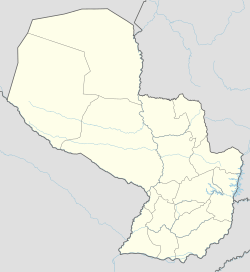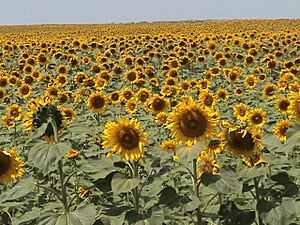Lima, Paraguay facts for kids
Quick facts for kids
Lima
|
||
|---|---|---|
|
||
| Country | Paraguay | |
| Department | San Pedro | |
| Founder | 1792 Fray Pedro Bartolomé | |
| Area | ||
| • Total | 992 km2 (383 sq mi) | |
| Population
(2008)
|
||
| • Total | 10,367 | |
| • Density | 13/km2 (30/sq mi) | |
| Time zone | -4 Gmt | |
| Postal code |
8430
|
|
Lima is a town in the San Pedro Department of Paraguay. It's a district located over 330 kilometers (about 205 miles) from the capital city, Asuncion.
Contents
- Discovering Lima: A District in Paraguay
- Getting Around Lima: Roads and Rivers
- Waterways of Lima: Rivers and Beaches
- Lima's Weather: Warm and Wet
- Languages Spoken in Lima
- People of Lima: Demographics
- Lima's Past: A Glimpse into History
- Lima's Economy: Farming and Livestock
- Fun in Lima: Tourism and Attractions
- See also
Discovering Lima: A District in Paraguay
Lima was founded in 1792 by Fray Pedro Bartolome. He started it as a mission for the Guanás Indigenous people, right by the Aguaray River. Later, in 1901, Lima officially became the second district of the San Pedro Department.
This district covers an area of about 992 square kilometers (383 square miles). In 2008, it had an estimated population of 10,367 people. This means there are about 13 people living in each square kilometer. Lima also has small airfields for planes.
Getting Around Lima: Roads and Rivers
You can reach Lima by using Route 3, called General Elizardo Aquino, or Route No. 11, Juana de Lara. However, most other roads in the area are not paved.
Despite this, Lima has public transport services. You can travel between districts or take daily buses to Paraguay's capital, Asuncion. Buses also go to other cities like Ciudad del Este, Pedro Juan Caballero, and even to neighboring countries like Brazil, Argentina, and Chile. The district also has an airport runway for small planes.
Lima's Neighbors: Borders and Rivers
Lima shares its borders with several other districts:
- To the north, you'll find Nueva Germania and Santa Rosa del Aguaray. The Aguaray Guazú River separates these districts.
- To the south are San Pablo and Choré. The Jejui Guazú River forms the border here.
- To the east, Lima borders the district of General Isidro Resquín.
- To the west, it's next to San Pedro de Ycuamandiyú and Nueva Germania. Again, the Aguaray Guazú River acts as a natural border.
Waterways of Lima: Rivers and Beaches
Lima is home to two important rivers:
- The Aguaray Guazú River is famous for its beautiful, creamy white sand beaches. These beaches are a popular spot for people to cool off when the weather is very hot.
- The Jejui Guazú River is known for being one of the cleanest rivers in Paraguay.
Lima's Weather: Warm and Wet
The climate in Lima is generally wet and rainy. The air usually feels quite humid, with humidity levels between 70% and 80%. The average temperature is around 23°C (73°F). In summer, temperatures can reach up to 35°C (95°F), while in winter, they can drop to about 10°C (50°F).
Languages Spoken in Lima
The main language spoken in Lima is Guaraní. About 80% of the people in the district speak it. The remaining 20% speak a mix of Spanish and Guaraní, often called "Jopara."
People of Lima: Demographics
According to a 2002 census, Lima had a total population of 10,367 people. Most of these residents, about 8,236 people, live in rural areas. Only 2,131 people live in the urban parts of the district. This means that nearly 80% of Lima's population lives in the countryside.
There are about 2,064 households in Lima. Most of these, 1,558, are in rural areas, showing that many families live outside the main town.
Here are some interesting facts about the people of Lima:
- About 43.5% of the population is under 15 years old.
- On average, women have about 3.6 children.
- About 8.4% of the population cannot read or write.
- Most people (67.6%) work in the primary sector, which includes farming and livestock.
- About 6.3% work in the secondary sector (like manufacturing).
- Around 25.1% work in the tertiary sector (services).
- A large number of people (67.3%) work in agriculture.
- About 78.4% of homes have electricity.
- Around 41.0% of homes have running water.
Lima's Past: A Glimpse into History
Lima is one of those towns that started in the late 1700s. It has strong ties to the Franciscan missionaries who helped establish it. Unlike some other towns known for farming, Lima has kept its old adobe church, which was built during the time of the Spanish Colony.
Land and Nature in Lima
The "INDERT" (formerly the Rural Welfare Institute) has set up special areas in Lima:
Communal Fields
These are areas of land set aside for the community to use.
- In 1984, the Colony Sargento Montanía was given 146 hectares (about 360 acres) of communal land.
- In 1998, the Colony San Jose del Norte received 179 hectares (about 442 acres).
Other colonies with communal lands include Loma Clavel, Mayor Hermosa-COSTA PUCU, and Mayor of Hermosa-Sgto. Montania.
Ecological Reserves
Lima is home to the CAPIITINDY Ecological Reserve. This protected area covers 102 hectares (about 252 acres) and was created in 1995 to help protect nature.
Indigenous Communities
The AVARIYU community is an Indigenous settlement in Lima. It covers an area of 237 hectares (about 585 acres) and was established in the 1980s and 1990s.
Lima's Economy: Farming and Livestock
Lima is an important center for farming and raising animals.
Main Economic Activities
- Livestock: People in Lima raise cattle, horses, sheep, and pigs.
- Agriculture: Farmers grow many different crops. These include mate (a popular tea-like drink), cotton, tobacco, sugar cane, cassava (a root vegetable), sesame, cedrón Paraguay, soy, beans, potatoes, alfalfa, citrus fruits (like oranges), peanuts, wheat, and sunflower.
The most important activity for many residents is growing and processing mate.
Income and Well-being
About 68.7% of the people in the San Pedro Department, which includes Lima, are considered poor. Even for those not officially classified as poor, daily needs can be challenging. On average, a family in Lima earns about 496,645 Guaraní per month. This works out to about 95,915 Guaraní per person each month.
Fun in Lima: Tourism and Attractions
Lima offers several attractions for visitors, especially those who enjoy nature.
Beaches and Resorts
The beaches along the Aguaray Guazú River are a big draw. They have white, clear sand and attract many local tourists. There are also health resorts and farms that visitors can enjoy.
One popular spot is the Raul Valiente health resort. It has beautiful beaches on the Aguaray River, along with picnic areas (Quinchos), sports fields, changing rooms, and canteens. It's a private place run by an association of taxi drivers.
Historic Sites
Lima still has its old adobe church, built during the Spanish colonial period. This church honors San Francisco and Virgen del Rosario. Even though a more modern church has been built, the old one remains an important historical attraction.
See also
 In Spanish: Lima (Paraguay) para niños
In Spanish: Lima (Paraguay) para niños




